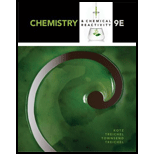
Chemistry & Chemical Reactivity
9th Edition
ISBN: 9781133949640
Author: John C. Kotz, Paul M. Treichel, John Townsend, David Treichel
Publisher: Cengage Learning
expand_more
expand_more
format_list_bulleted
Question
Chapter 20.2, Problem 1RC
Interpretation Introduction
Interpretation: The enthalpy change for this reaction form the enthalpies of the three reactions should be determined.
Concept Introduction:
Standard enthalpy of the reaction,
Enthalpy of the reaction,
Expert Solution & Answer
Want to see the full answer?
Check out a sample textbook solution
Students have asked these similar questions
Calculate the pH and the pOH of each of the following solutions at 25 °C for which the substances ionize completely:
(a) 0.200 M HCl
Calculate the pH and the pOH of each of the following solutions at 25 °C for which the substances ionize completely:
(a) 0.000259 M HClO4
What is the pH of a 1.0 L buffer made with 0.300 mol of HF (Ka = 6.8 × 10⁻⁴) and 0.200 mol of NaF to which 0.160 mol of NaOH were added?
Chapter 20 Solutions
Chemistry & Chemical Reactivity
Ch. 20.1 - Prob. 1RCCh. 20.1 - Prob. 2RCCh. 20.2 - Prob. 1RCCh. 20.2 - Prob. 2RCCh. 20.3 - Prob. 1RCCh. 20.3 - Prob. 2RCCh. 20.3 - Prob. 3RCCh. 20.4 - Prob. 1RCCh. 20.4 - Prob. 2RCCh. 20.4 - 3. Which of the following is a renewable energy...
Ch. 20.5 - Prob. 1RCCh. 20.5 - Prob. 2RCCh. 20.6 - Prob. 1QCh. 20.6 - Prob. 1RCCh. 20.7 - Prob. 1QCh. 20.7 - Prob. 2QCh. 20 - In the discussion on the composition of air,...Ch. 20 - Prob. 2PSCh. 20 - Prob. 3PSCh. 20 - Dinitrogen monoxide, N2O (commonly called nitrous...Ch. 20 - Prob. 5PSCh. 20 - Prob. 6PSCh. 20 - Prob. 9PSCh. 20 - Although there are a number of...Ch. 20 - Prob. 12PSCh. 20 - Prob. 13PSCh. 20 - Prob. 14PSCh. 20 - Prob. 15PSCh. 20 - Prob. 17PSCh. 20 - The enthalpy of combustion of isooctane (C8H18),...Ch. 20 - Energy consumption in the United States amounts to...Ch. 20 - Prob. 20PSCh. 20 - Prob. 23PSCh. 20 - Prob. 25PSCh. 20 - Prob. 28PSCh. 20 - In methane hydrate the methane molecule is trapped...Ch. 20 - Prob. 30PSCh. 20 - Prob. 31PSCh. 20 - Prob. 32PSCh. 20 - Prob. 33PSCh. 20 - Prob. 34PSCh. 20 - Prob. 35GQCh. 20 - Prob. 36GQCh. 20 - Prob. 37GQCh. 20 - Prob. 38GQCh. 20 - Prob. 40GQCh. 20 - Prob. 41ILCh. 20 - Prob. 42ILCh. 20 - Define the terms renewable and nonrenewable as...Ch. 20 - Prob. 44SCQCh. 20 - Prob. 45SCQCh. 20 - Prob. 46SCQCh. 20 - Prob. 47SCQCh. 20 - What is the likelihood that hydrogen (H2) will...Ch. 20 - Prob. 49SCQCh. 20 - Which sulfur compounds are atmospheric pollutants?...
Knowledge Booster
Similar questions
- Determine if the following salt is neutral, acidic or basic. If acidic or basic, write the appropriate equilibrium equation for the acid or base that exists when the salt is dissolved in aqueous solution. If neutral, simply write only NR. Be sure to include the proper phases for all species within the reaction. NaN₃arrow_forwardCan I please get help with this?arrow_forwardCan I please get help with this?arrow_forward
- Use the Henderson-Hasselbalch equation to calculate pH of a buffer containing 0.050M benzoic acidand 0.150M sodium benzoate. The Ka of benzoic acid is 6.5 x 10-5arrow_forwardA. Draw the structure of each of the following alcohols. Then draw and name the product you would expect to produce by the oxidation of each. a. 4-Methyl-2-heptanol b. 3,4-Dimethyl-1-pentanol c. 4-Ethyl-2-heptanol d. 5,7-Dichloro-3-heptanolarrow_forwardWhat is the pH of a 1.0 L buffer made with 0.300 mol of HF (Ka = 6.8 × 10⁻⁴) and 0.200 mol of NaF to which 0.160 mol of NaOH were added?arrow_forward
- Can I please get help with this.arrow_forwardDetermine if the following salt is neutral, acidic or basic. If acidic or basic, write the appropriate equilibrium equation for the acid or base that exists when the salt is dissolved in aqueous solution. If neutral, simply write only NR. Be sure to include the proper phases for all species within the reaction. N₂H₅ClO₄arrow_forwardPlease help me with identifying these.arrow_forward
arrow_back_ios
SEE MORE QUESTIONS
arrow_forward_ios
Recommended textbooks for you
 Chemistry: The Molecular ScienceChemistryISBN:9781285199047Author:John W. Moore, Conrad L. StanitskiPublisher:Cengage Learning
Chemistry: The Molecular ScienceChemistryISBN:9781285199047Author:John W. Moore, Conrad L. StanitskiPublisher:Cengage Learning Chemistry & Chemical ReactivityChemistryISBN:9781337399074Author:John C. Kotz, Paul M. Treichel, John Townsend, David TreichelPublisher:Cengage Learning
Chemistry & Chemical ReactivityChemistryISBN:9781337399074Author:John C. Kotz, Paul M. Treichel, John Townsend, David TreichelPublisher:Cengage Learning Chemistry & Chemical ReactivityChemistryISBN:9781133949640Author:John C. Kotz, Paul M. Treichel, John Townsend, David TreichelPublisher:Cengage Learning
Chemistry & Chemical ReactivityChemistryISBN:9781133949640Author:John C. Kotz, Paul M. Treichel, John Townsend, David TreichelPublisher:Cengage Learning Chemistry: Principles and PracticeChemistryISBN:9780534420123Author:Daniel L. Reger, Scott R. Goode, David W. Ball, Edward MercerPublisher:Cengage Learning
Chemistry: Principles and PracticeChemistryISBN:9780534420123Author:Daniel L. Reger, Scott R. Goode, David W. Ball, Edward MercerPublisher:Cengage Learning Introductory Chemistry: A FoundationChemistryISBN:9781337399425Author:Steven S. Zumdahl, Donald J. DeCostePublisher:Cengage Learning
Introductory Chemistry: A FoundationChemistryISBN:9781337399425Author:Steven S. Zumdahl, Donald J. DeCostePublisher:Cengage Learning

Chemistry: The Molecular Science
Chemistry
ISBN:9781285199047
Author:John W. Moore, Conrad L. Stanitski
Publisher:Cengage Learning

Chemistry & Chemical Reactivity
Chemistry
ISBN:9781337399074
Author:John C. Kotz, Paul M. Treichel, John Townsend, David Treichel
Publisher:Cengage Learning

Chemistry & Chemical Reactivity
Chemistry
ISBN:9781133949640
Author:John C. Kotz, Paul M. Treichel, John Townsend, David Treichel
Publisher:Cengage Learning

Chemistry: Principles and Practice
Chemistry
ISBN:9780534420123
Author:Daniel L. Reger, Scott R. Goode, David W. Ball, Edward Mercer
Publisher:Cengage Learning

Introductory Chemistry: A Foundation
Chemistry
ISBN:9781337399425
Author:Steven S. Zumdahl, Donald J. DeCoste
Publisher:Cengage Learning